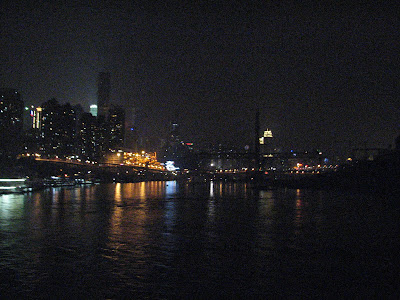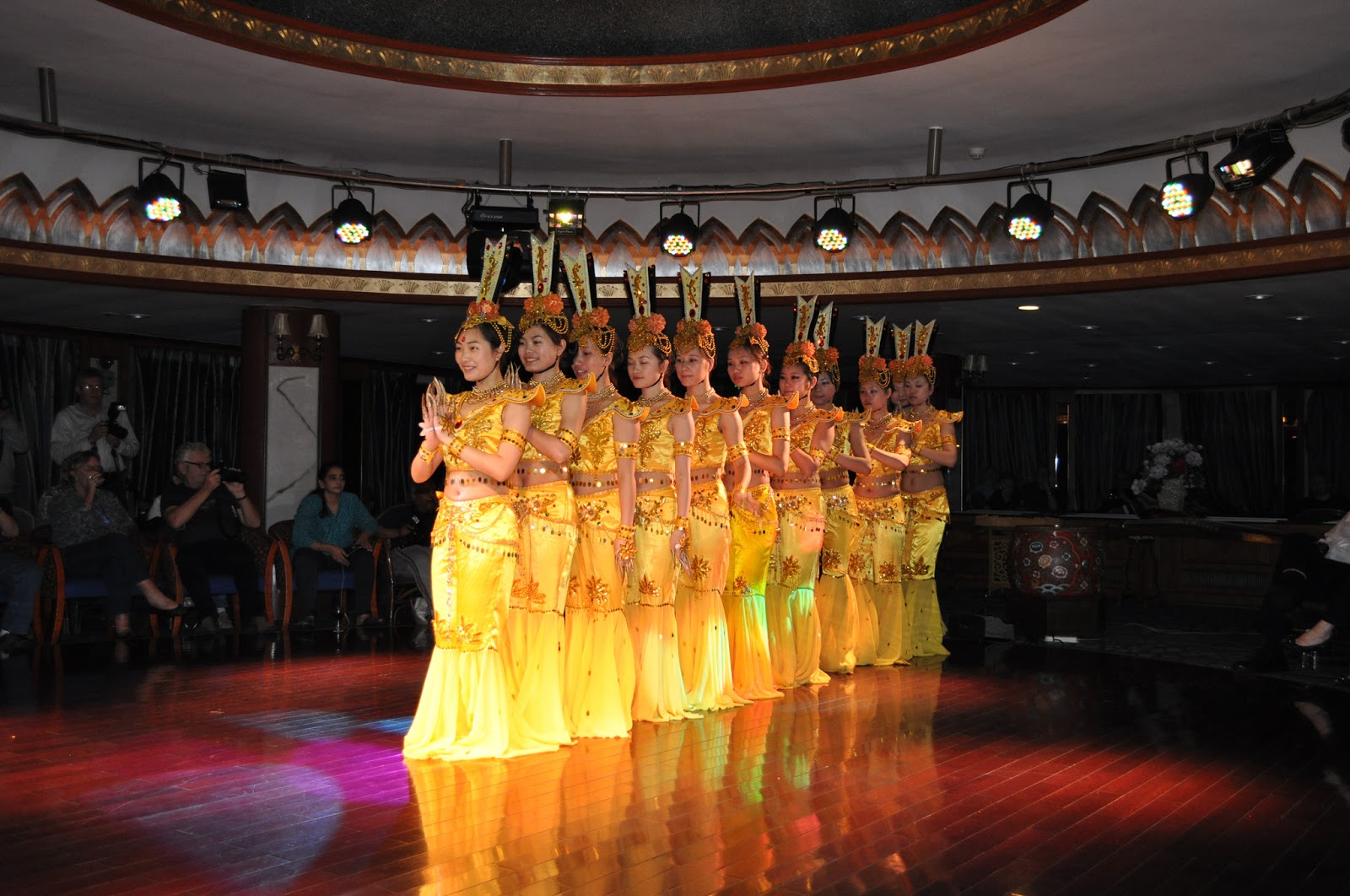 |
| Our cruise ship. |
 |
The ship is run by an American company, so it has higher standards than some we saw on the river. We traded our larger stateroom for Don's smaller one so he could be next door to his daughter and grandson, but the room was still just fine.
 |
| Nap time--softer bed than most Chinese ones! |
 |
| The long hallway. |
We had cabin service at least twice a day, and the staff was really friendly and helpful.
At 6:45a.m., we got up and went to the Lounge for our Tai Chi lesson with none other than Dr. Hu. (Say that out loud.) People laughed when he was introduced. We made sure that he understood what a cool guy Dr. Who is to BBC TV watchers.
Our first port of call was Fengdu, one of the towns that is now submerged. A new town has been built on the opposite side of the river for the displaced citizens (now numbering 100,000). Fengdu is still the famous Ghost City, and we disembarked to explore the Ghost Temple and the "King of Hell".
No, that's not the "King of Hell". It's a bad hotel idea. This is the "heaven" side of the mountain, and someone had the brilliant idea to build a hotel that looked like an emperor. However, after building this much, people convinced him that no one was going to want to stay in a hotel that close to the Ghost Temple. There is still a lot of superstition in China. So here stands another of the many empty buildings in China.
 |
| Now HERE'S the Temple of Hell--check out the demons who greet you on either side! |
Buddhist, Taoist and Confucian, the complex is actually a series of temples. We first stopped at the Temple of Heng and Ha, the Buddhist door guardians. Our tour guide led us in a "Heng--Ha" shout to invoke their protection as we visited the Ghost City.
Apparently, the little guys under their feet did something naughty!
Lovers hold hands on this central bridge and step exactly nine steps (an auspicious Chinese number) to cross it in order to insure eternal love and happiness. Previous editions of travel guides say that this is the Modoribashi or "Nothing to Be Done" bridge, and if you are wicked and try to cross it, you will fall into the water. Sounds like they changed the story so that people would be more likely to buy the photo they take of you as you are crossing over. This is the first of three "tests" you are supposed to pass on your way to the netherworld to determine your fate.
 |
| I was interested in the three similar-looking Buddhas in this temple. |
This character means "Only Kindness Brings Peace". That's an interesting thought for the Ghost City.
The Boddhisattva Guanyin is the famous goddess of mercy and fertility.
The second test for spirits is to pass through the Ghost Torturing Pass. One of the ghost statues lining the passage to hell has this naughty child with its rump sticking up. We were told that if we "spanked" it, our grandchildren would never be naughty. I spanked it--is it working?
There are several bizarre ghost statues and you must pass by them on your way. Step carefully over the gate--women with the right foot, men with the left--or your gender will change in the next life.
This is the "Saying Goodbye to the Past" Tower with no staircase inside, because only the spirits go in it to look back on their life and say goodbye for the last time.
At the top of the mountain is the Black Temple, the only black one in China. This was not destroyed during the Cultural Revolution because even the Red Guards were afraid of spirits. The walls are painted black, and the third test is carried out in front before you pass inside.
Inside this cement box is a round stone that sticks up in the middle. You have to balance on one foot while staring at the characters on the wall above you for 3 seconds (I read somewhere it used to be 3 minutes--maybe they shortened it to allow each of the million tourists a turn). If you don't fall down, you are "good" and will not be sent to be tortured for 500 years.
Whew, I passed!
Inside the Black Temple, your fate is determined. The "King of Hell" is more like the Greek god Hades; not a devil or evil spirit. To Chinese, the social structure in the underworld is exactly like that in the real world, so you must go through a bureaucracy of officials to receive your judgment. First you pass 8 "policemen".
Chinese cops.
Check out the three "bad" babies in this guy's belt!
If you get past the policemen, you next see the 4 judges.
And finally you face him, King of the Underworld.
And by the way, did you know he's married?
 |
| Wife of the King of the Underworld |
If you are innocent and virtuous, you will have a happy eternity. However, if you are wicked, you will receive a punishment commensurate with your crime. The Chinese imagination has gone wild in considering all the ways to torture a person for 500 years. I'll only post a few to spare you the gruesomeness!
OK, that's enough of that!! It's a good thing there was so much dust on everything. I don't know if I'd want to see them all "fresh-looking"!! It was quite a freak show.
The Wuyun Tower on top of Ming Mountain is visible from the Yangtze and was used as a lighthouse as well.
 |
| Our ship from the Ghost Temple--we're 400 steps up! |
Tombs in the hillside.
 |
| Kurt & Jackie Roberts teach me to play "golf". |
Thousand Hands Dance
Ancient Chinese Dance
Notice the wooden clogs the dancers are wearing in the video.
If you don't like the Chinese show, you can make up your own later, when no one is around.








































Oi, the torture pictures made me queasy!
ReplyDeleteHahaha! Dr. Hu
ReplyDelete